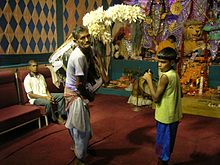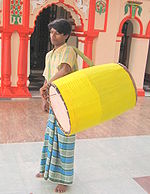- Dhaki
-
Dhakis (Bengali: ঢাকি) are traditional drummers who play the dhak (drum) during Hindu festivals, primarily in Bengal. Drum beats are an integral part of the five-day long annual festivities associated with Durga Puja[1] but dhakis are losing out to pre-recorded CDs and cassettes.[2]
Contents
The players
Dhakis perform mostly in pandals of barowari pujas, starting from Viswakarma Puja till Kali Puja, but are most prominent during Durga Puja. For the latter festival Kolkata has over 2,000 pandals, with numerous more in the districts. Even a small pandal without the beat of dhaks is unimaginable. Every makeshift tent has a dhak.[3]
The Statesman writes “Durga Puja does not assume the festive aura without the maddening beats of the dhak, the large drum that men hang around their necks and play with two thin sticks to infuse the frenzied rhythm into listeners. Those enchanting beats are enough to conjure up the sights and smells of Durga Puja.”[4]
The nuances of playing the instrument are handed down from generation to generation, but the old rhythms are undergoing changes. The rhythm is no longer as slow as in earlier generations. Nowadays, dhakis opt for faster tunes. Before, different beats were used for specific aspects of Durga Puja, as for example chokhhu daan (eye presentation), patha bali (goat sacrifice), bisarjan (immersion ceremony), sandhya arati (evening offerings), sandhipuja (worshiping at the conjunction of two phases), and so on.[4]
Dhakis who cannot learn within the family typically take training under a guru in order to become a good dhaki, as is the case for most musical instruments. Some take six months to become mature players, while others do not even learn after three or four years. Many young dhakis nowadays are moving towards modern rhythms. Bikram Ghosh, a renowned tabla player and a patron of dhakis in Bengal, opines, “some dhakis do go the commercial way out of necessity. But most know the basic rhythms that have been taught to them by their ancestors.”[4]
The occasions when the dhak was played are changing. Apart from pujas or religious festivities, dhakis are also called to play in markets before Durga Puja when people crowd in large numbers. Sometimes, they are called for store inaugurations.[4]
Outside Bengal
Bengali communities outside Bengal get dhakis from Bengal for Durga Puja. In Delhi around 400 Durga Pujas are organised. Many of the older and established pujas have their fixed dhakis, but others engage free-lancers who arrive on their own in Delhi just before the pujas. Some 100 dhakis travel to Delhi from Malda and Medinipur. Not all of them are engaged and some return empty handed.[5]
Durga Puja is the time for the dhakis to earn some money. They are generally landless farmers and play the dhak in their villages when they have time to spare. The cost of a dhaki in Delhi is a little more than it is in Kolkata. It costs around Rs. 3,000 to 4,000 per dhaki plus Rs. 2,000 for the accompaniments.[5]
The dhakis routinely brave police harassment in order to reach the capital with their large dhaks. With terrorism in the air, the harassment has increased. Even after checking with metal detectors for guns and bombs, the police do not allow them to go unless they pay. The return journey is more hazardous because they have money in their pockets.[5]
Dhaks appear in the numerous Durga Puja pandals at Patna.[6] In Jamshedpur, they also have a competition for dhakis.[7] Dhakis travel to far way places like Hyderabad and Kochi for Durga Puja.[8][9]
Sushil Das, a dhaki from Sukbazar village near Bolpur had an invitation to go to the USA, but could not accept it because of his lack of knowledge of English. A highly skilled dhaki, he can play six dhaks at a time. Some Indians residing in the USA were impressed by his performance in a puja pandal in Delhi and offered to take him to the USA.[10]
Changing times
The art of playing the dhak is now being referred to as a dying profession. While some of the dhakis may be lucky to retain old contacts, many are facing a decline and some are moving away from the traditional profession. Take the example of the seventy dhaki families in Amrul, a village in Bankura district. Ancestors of the dhakis were on the rolls of Malla kings of Bishnupur. Daily pujas were organised for the deities in the palace and the dhakis played a significant role. Times have changed. One of them was offered Rs. 800 for playing the dhak for five days. It is a pittance. Some of the younger generation even took to work as shoe shine boys, but the older generation still has pride in being artists. They look down upon such misadventures of the younger generation, but do not have an alternative before themselves.[11]
Nottopara, in the Ashoknagar Kalyangarh area of North 24 Parganas district, is a locality of dhakis, who came as refugees from East Bengal. The locality is named after them, and some thirty-five to forty families live there. They regret, “earlier, we used to be treated like any other artist. Today, we are just another component of the Puja paraphernalia, who are supposed to perform on those days.“ Earlier, they used to be from around Mahalaya, but now go only for the five days. The importance of dhakis has diminished because of some people's preference for electronic music and bands. These days, some of the Nottos make dhaks. A dhak made of mango wood and goat skin sells for around Rs 3,000 to Rs 3,500, leaving a profit of only Rs 50. Some have taken to other professions.[12]
There is another Nattapara in Hooghly district, a remote village in Balagarh block. There are some 100 dhakis in the village. There is not a single family without a dhaki. All used to go out to work as dhakis during the festive season, but now the demand has declined to such an extent that many are forced to give up the traditional profession and work as wage labourers. Worse still, a dhaki from the village was contacted by a well-known Durga Puja in Kolkata for Rs. 2,000. After he had performed his duties they paid him less and insulted him.[13] It is not an isolated incident and there are similar complaints from dhakis in the Tarakeswar and Dhaniakhali regions.[14]
Dhakis are losing out to technology. While music shops do brisk business in selling pre-recorded CDs and cassettes for anything between Rs. 23 and 40, dhakis find it hard to earn Rs. 150 to Rs. 200 per day, poor compensation considering the cost or hire charges of the dhak, the training that the dhaki must undergo, and the effort involved.[2]
Killing of birds
Maneka Gandhi, an animal rights activist, says that dhakis try to attract the attention of puja organisers by decorating the dhaks with bird feathers. She charges that “Dhakis kill more than 40,000 egrets, pheasants, herons and open bill storks every year. The killing increases with each passing year. Murshidabad, Nadia, Burdwan, Birbhum and Bankura are notorious for this misdeed.”[3]
The feathers of wild birds play an indispensable role in controlling pests. However dhakis use these to decorate the drums.It assists in attracting the attention of puja organisers.[3]
All the birds killed are protected species and the open bill stork is endangered. In India, it is illegal to trap, sell, hunt, buy or kill any wild bird under the Wildlife Protection Act 1972. The crime is a non-bailable one and anyone convicted of killing a protected bird can be imprisoned for up to seven years and/or fined Rs. 25,000. Under the Act, it is illegal to buy or sell animal parts. They are sold anywhere in the range between for Rs. 300 to Rs. 600 per kilo.[3]
The law exists, but law keepers turn a blind eye to it.[3]
Documentary film
Gautam Chattopadhyay has made a documentary film about dhakis.
References
- ^ "Traditions of Durga Puja". Society for confluence of festivals in India. http://www.durga-puja.org/tradition.html. Retrieved 2008-01-13.
- ^ a b Gomes, Julius. "Technology sounds death knell for Dhakis". Kolkata Plus, Bengal Plus, North Bengal & Sikkim. The Statesman, 7 October 2007. http://www.thestatesman.net/page.arcview.php?clid=10&id=52924&usrsess=1. Retrieved 2008-01-13.[dead link]
- ^ a b c d e Gandhi, Maneka. "Think Again:Crime and No Punishment". 8th Day. The Statesman, 13 January 2008. http://www.thestatesman.net/page.news.php?clid=30&id=185669&usrsess=1. Retrieved 2008-01-13.[dead link]
- ^ a b c d Bhattachatya, Kajari. "Beats of changing time". Kolkata Plus. The Statesman, 26 September 2006. http://www.thestatesman.net/page.arcview.php?clid=22&id=158534&usrsess=1. Retrieved 2008-01-13.[dead link]
- ^ a b c Ghosh, Abantika (2006-09-26). "Beating their drums". Times of India, 26 September 2006. http://timesofindia.indiatimes.com/articleshow/2026947.cms. Retrieved 2008-01-13.
- ^ Singh, Bhanu Pratap (2001-10-22). "Come Puja, Patna doesn’t miss the touch of Bengal". Times of India, 22 October 2001. http://timesofindia.indiatimes.com/articleshow/1165551762.cms. Retrieved 2008-01-13.
- ^ "Drummers set festival rhythm - Dhaki contest adds to Aambagan Durga Puja attraction". PTI. The Telegraph, 14 October 2002. http://www.telegraphindia.com/1021014/asp/jamshedpur/story_1290116.asp. Retrieved 2008-01-13.
- ^ "Bengalis celebrate Onam in Kochi". National. The Hindu, 27 August 2007. http://www.hinduonnet.com/thehindu/thscrip/print.pl?file=2007082760651100.htm&date=2007/08/27/&prd=th&. Retrieved 2008-01-13.
- ^ Ramamoorthy, Mangala. "At ease… away from home". Metro Plus Hyderabad. The Hindu, 26 September 2007. http://www.hinduonnet.com/thehindu/mp/2006/09/26/stories/2006092600700100.htm. Retrieved 2008-01-13.
- ^ Roy, Sabyasachi. "Language barrier stifles dhak beat". The Statesman, 12 October 2005. http://www.thestatesman.net/page.arcview.php?clid=22&id=120762&usrsess=1. Retrieved 2008-01-13.[dead link]
- ^ Siddiqui, Kanchan. "Drumbeats of a dying profession". Bengal Plus. The Statesman, 16 October 2003. http://www.thestatesman.net/page.arcview.php?clid=23&id=53673&usrsess=1. Retrieved 2008-01-13.[dead link]
- ^ "Dhakis the ones less looked forward to this Puja". Bengal Plus. The Statesman, 12 October 2004. http://www.thestatesman.net/page.arcview.php?clid=23&id=85127&usrsess=1. Retrieved 2008-01-13.[dead link]
- ^ "Dhakis lose out to cassettes". Bengal. The Statesman, 3 October 2002. http://www.thestatesman.net/page.arcview.php?clid=6&id=3272&usrsess=1. Retrieved 2008-01-13.[dead link]
- ^ "Dhakis the ones less looked forward to this Puja". Bengal. The Statesman, 12 October 2004. http://www.thestatesman.net/page.arcview.php?clid=23&id=85127&usrsess=1. Retrieved 2008-01-13.[dead link]
Bengali culture General Art · Architecture of Bengal · Architecture of Bangladesh · Calendar · Cinema · Cuisine · History · Language · Literature · Music · Poetry · Renaissance · Script · Sport (Bangladesh) · Theatre · Wedding · Bengali people (list)
Specific Dhaki · Fairs in Birbhum · Folk literature · Jatra · Maimansingha Gitika · Nabanna · Panjika · Pohela Baishakh · Poush Mela · Rabindra Sangeet · Tarja
Folk songs and dances Crafts Bankura horse · Craft centres in West Bengal · Dhakai · Dhokra · Jamdani · Kantha · Nakshi Kantha · Sholapith
Categories:- Occupations in music
- Culture of West Bengal
- Indian musical instruments
Wikimedia Foundation. 2010.


